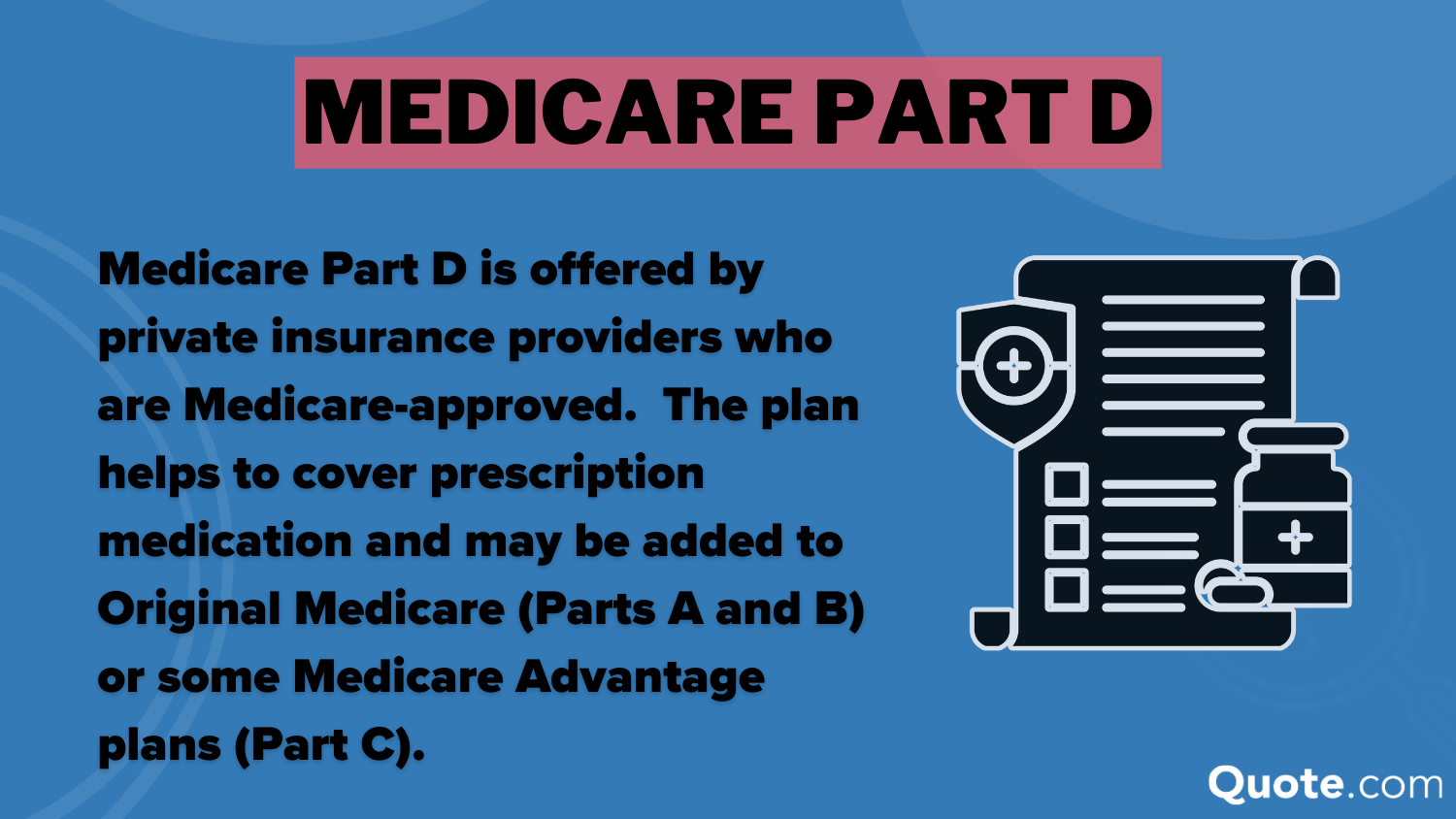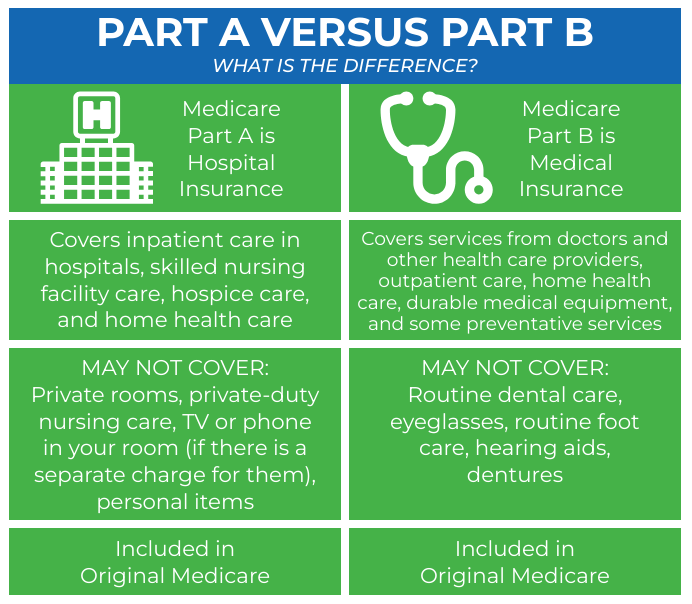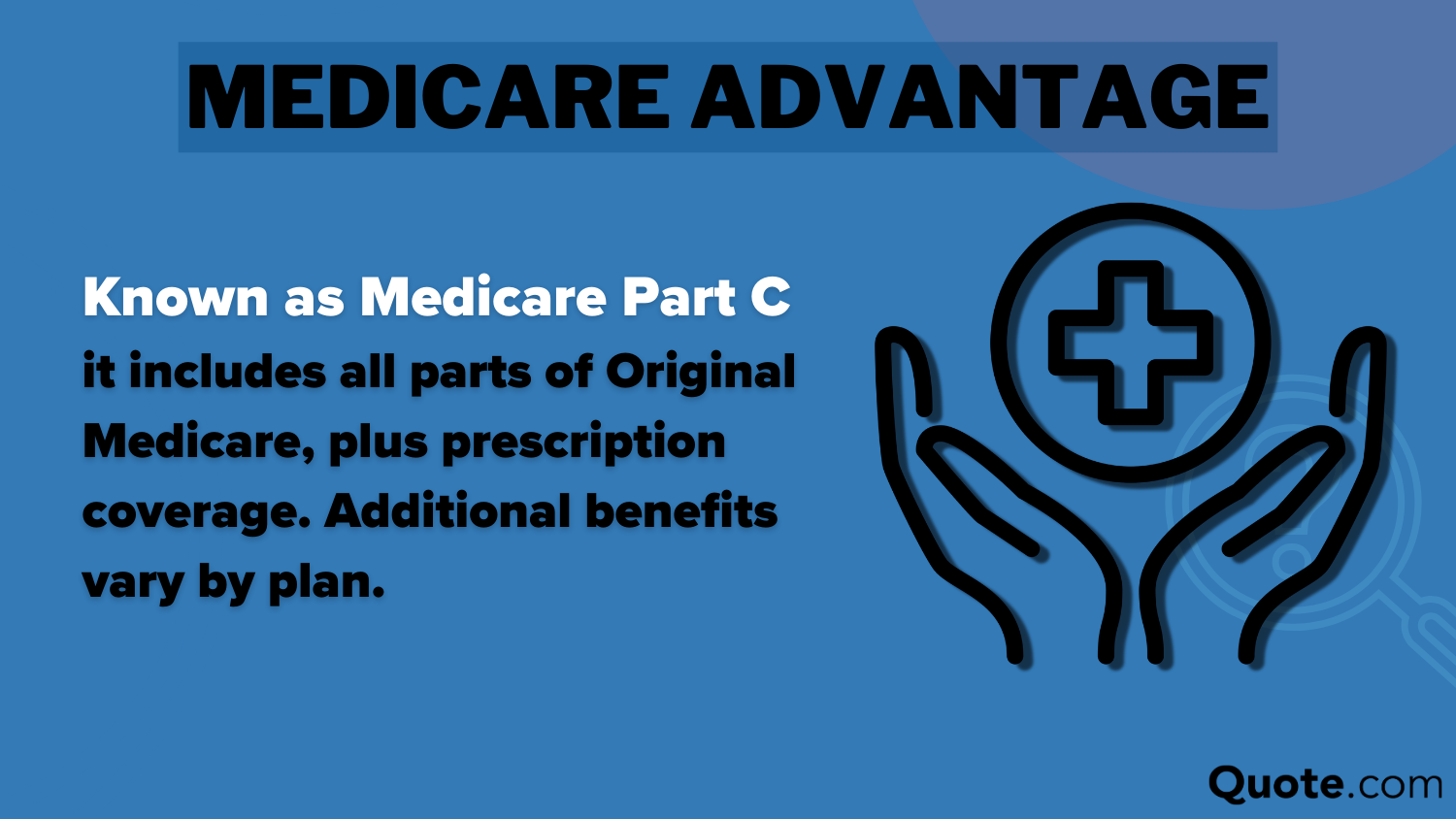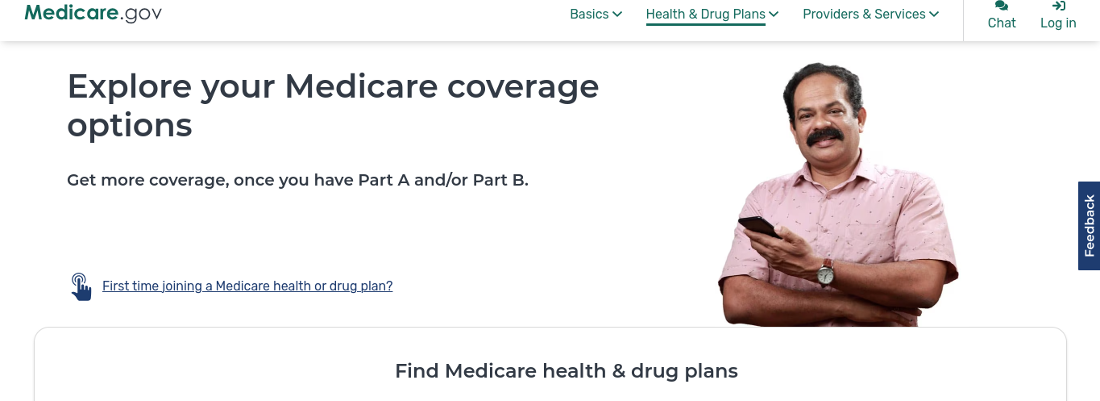What is Medicare Part D? (Coverage Details for 2025)
What is Medicare Part D? Medicare Part D covers prescription drugs, which Original Medicare excludes. Plans start at $34 monthly and cover essential medications like cancer treatments. Medicare Part D plans vary, so review formularies, copays, and provider networks to secure the best prescription.
Free Medicare Insurance Comparison
Compare Quotes From Top Companies and Save
Secured with SHA-256 Encryption

Adam Lubenow
Medicare Broker
Adam Lubenow is a partner in his family business, Senior Advisor, which specializes in bringing clarity to the Medicare enrollment process and coverage options to ensure that clients are making informed decisions. Senior Advisors is licensed to help clients in over 40 states and has offices in Arizona and New Jersey. Prior to joining the family business, Adam spent his career with Verizon Busin...
Medicare Broker
UPDATED: Jun 17, 2025
It’s all about you. We want to help you make the right legal decisions.
We strive to help you make confident insurance and legal decisions. Finding trusted and reliable insurance quotes should be easy. This doesn’t influence our content. Our opinions are our own.
Editorial Guidelines: We are a free online resource for anyone interested in learning more about insurance. Our goal is to be an objective, third-party resource for everything legal and insurance related. We update our site regularly, and all content is reviewed by experts.
UPDATED: Jun 17, 2025
It’s all about you. We want to help you make the right legal decisions.
We strive to help you make confident insurance and legal decisions. Finding trusted and reliable insurance quotes should be easy. This doesn’t influence our content. Our opinions are our own.
On This Page
What is Medicare Part D? When you sign up for Medicare, you have the option to add a Part D plan for your medications. Original Medicare does not cover prescription drugs. Enrolling in Medicare prescription drug coverage ensures you don’t lose affordable access to necessary medications.
Part D isn’t required, but skipping it can be costly, there is a 1% penalty for every month you go without it.
Scroll through this guide to learn how Medicare Part D works and discover how you can maximize your Medicare benefits. Then enter your ZIP code to compare plans from local Medicare Part D companies.
- Medicare Part D covers prescriptions Original Medicare excludes
- Enrolling on time avoids penalties and ensures medication access
- Compare plans to find the best premiums, copays, and drug coverage
Medicare Part D Explained
Medicare Part D plans were created in 2006 to help seniors pay for expensive prescriptions. Prescription drugs are tiered based on class, with higher and specialty tiers having higher copayments.
What drugs are covered by Medicare Part D? Most providers update the formulary every year or whenever the FDA announces a recall. Prescriptions are tiered based on class, so copayments will vary based on which class of drug you need:
- Tier 1: Mostly generic prescriptions with the cheapest copayments.
- Tier 2: More preferred or brand-name drugs than Tier 1, so copayments are slightly higher.
- Tier 3: Mostly non-preferred, brand-name prescriptions with the highest copayments.
A specialty tier also exists for very expensive prescriptions or exemptions. If you can’t afford a certain prescription or want to find a better price, talk to your doctor about comparable drugs in lower tiers.
The government requires Medicare to offer at least two prescriptions in each class. However, there are over 700 different Part D plans, and each has a different formulary listing the covered prescriptions. Insurance companies can also change their formulary list at any time.
Before you renew coverage, shop around and compare the list of covered prescriptions to ensure that yours is still on it. Medicare Savings Programs (MSPs) can help reduce prescription costs to $11.
To qualify, you must meet the MSP income requirements. If you don’t, Medicare Supplemental Insurance, also known as Medigap, can cover some costs for an additional monthly premium and deductible.
If you can’t find your specific prescription on any plan’s formulary, you can ask for an exception. Your doctor or prescribing physician must write a supporting statement explaining why this specific medication is necessary.
Original Medicare (Parts A and B) does not cover prescription drugs. It only covers medical costs and hospital stays.
Medicare Part D vs. Original Medicare
What is Medicare Part A? Part A is hospital insurance that pays for hospital stays and nursing home or hospice care. What is Medicare Part B? This part if your policy covers routine medical services and equipment.
Original Medicare is only designed for hospital and medical care and doesn’t cover prescriptions. Every Medicare Part D plan is required to cover a wide range of prescriptions, including cancer and HIV/AIDS treatments.
Read More: Millennial’s Guide to Health Insurance
Enter your zip code below to view companies that have cheap insurance rates.
Secured with SHA-256 Encryption
Comparing Medicare Part D Costs
Medicare Part D costs $34 a month for everyone, but the private insurance companies selling plans set their own deductibles.
Medicare Costs by Plan Type| Medicare Plan | Monthly Premium | Annual Deductible | Out-of-Pocket Max |
|---|---|---|---|
| Part A | $0-$505 | $1,632 | N/A |
| Part B | $174 | $240 | N/A |
| Part C | $0-$200 | $0-$200 | $8,850 |
| Part D | $34 | $0-$545 | $2,000 |
| Medigap | $35-$488 | $0-$2,800 | $3,500-$7,500 |
Your monthly Part D premium does not include your prescription copayments. Out-of-pocket costs can vary based on where you live and the provider you choose.
Medicare Advantage vs. Medicare Part D Plan Comparison
What is Medicare Part C? Sometimes called Medicare Advantage Plans, Medicare Part C is a stand-alone health policy that combines Original Medicare (Parts A and B) with Medicare Part D.
With Medicare Advantage, you pay one premium for all your coverage instead of separate monthly plans for Part A, Part B, and Part D.
However, like Part D plans, Medicare Advantage plans have different formulary lists of brand-name and generic drugs. Compare multiple plans and companies online before you enroll.
How to Get Medicare Prescription Drug Coverage
There are two ways to get prescription drug coverage through Medicare: Medicare Part D or Medicare Advantage plans that include Part D. The good news is you enroll for either policy the same way on Medicare.gov.
Who is eligible for Medicare Part D? Part D is unavailable until you turn 65. There are specific enrollment periods around your 65th birthday when you can sign up for Medicare prescription drug coverage:
- Initial Enrollment Period (IEP): Starts three months before you turn 65 and ends three months after your birthday month
- Annual Enrollment Period (AEP): Between October 15 and December 7
- Open Enrollment Period (OEP): Between January 1 and March 31 for those who already have Medicare Advantage plans and need to change their coverage
- Special Enrollment Period (SEP): Must meet certain criteria to enroll, such as moving to another state or if your Medicare provider changes its coverage options.
Your IEP is the best time to sign up since you’ll have access to the lowest prices. Waiting to enroll can make it harder to get prescription coverage later. You’ll also pay a 1% penalty for every month you didn’t Part D. If you’re still working or otherwise insured by an employer’s or spouse’s insurance policy, you won’t pay any penalties.
Maximizing Benefits Under Medicare Part D
What is Medicare Part D? Part D is an essential add-on to Original Medicare for covering prescription drugs, which is not included in Parts A and B. Medicare Advantage plans often bundle prescription coverage, offering a more streamlined and potentially cost-effective solution if you’re looking for ways to finance what your health insurance won’t cover.
Enrolling in Medicare Part D can be done during specific periods around your 65th birthday. There are penalties for delayed enrollment unless covered by another insurance policy. Prescription costs are tiered, with higher tiers costing more.
Skipping Medicare Part D leads to late penalties and high drug costs. For example, a 1% fee is added for every month without coverage.
Jeff Root Licensed Insurance Agent
Discuss alternative medications with your doctors or seek plans with better coverage for prescriptions if copayments are too expensive. Additionally, you can compare insurance companies online to find affordable Medicare Part D plans near you.
Frequently Asked Questions
What is the average monthly cost of Medicare Part D?
What is the monthly cost of Medicare Part D? Medicare Part D premiums cost $34 montly for all beneficiaries. Coverage options influence how much Medicare costs each month, affecting your overall budget. Explore further.
What is Medicare Part D, and how does it work?
Medicare Part D is an essential add-on to cover prescription drugs. Original Medicare doesn’t cover prescriptions, so you need to shop for Part D plans to help pay for your medication.
Does everyone pay for Medicare Part D?
Yes, everyone needs to enroll in Medicare Part D unless they have prescription coverage through another insurance plan. Enter your ZIP code to start comparing Medicare Part D plans near you.
How do you know if you have Medicare Part D?
Your Medicare Part D coverage is listed on your Medicare insurance card or Social Security benefits statement.
Can you add Medicare Part D at any time?
No, you can only sign up for Medicare during the Initial, Annual, or Special enrollment periods. Find out how to sign up for Medicare and ensure you enroll on time.
What will Medicare Part D not cover?
Medicare Part D doesn’t cover hospital stays or medical supplies. It only covers prescriptions listed on the plan’s formulary.
What is the maximum out-of-pocket for Part D?
The annual out-of-pocket maximum for Medicare Part D is $2,000.
Do you have to pay a deductible for Medicare Part D?
No, but you are responsible for paying any prescription copayment or coinsurance costs.
What is Medicare Part G?
Medicare Part G is a type of Medigap plan that provides supplement coverage to pay for excess costs and some Parts A and B copays.
Do you need Part D if you have Medicare Advantage?
No, because most Medicare Advantage plans include prescription coverage.
What are the disadvantages of Medicare Part D?
Expensive copayments and other out-of-pocket costs are the biggest complaints from beneficiaries.
What happens if you refuse Medicare Part D?
You incur a 1% penalty for every month you aren’t enrolled in Part D or another insurance plan.
Why was I automatically enrolled in Medicare Part D?
If you’re already enrolled in Medicaid or a Supplemental Security Income program, you will be automatically signed up for Original Medicare and Medicare Part D.
What does Medicare Part C cover?
Your Medicare Part C, or Medicare Advantage plan, includes hospital, medical, and often prescription drug coverage. Some plans also offer dental, vision, and hearing benefits.
Do you automatically get Medicare Part D?
You are not automatically enrolled in Medicare Part D. You must sign up during your Initial Enrollment Period or a Special Enrollment Period to avoid penalties.
Is it worth getting Medicare Part D?
Is Medicare Plan D worth it? If you need prescription medications, Medicare Part D helps lower drug costs and prevents high out-of-pocket expenses. Without it, you may face costly prescriptions.
What is the most popular Medicare Part D plan?
The most popular Medicare Part D plans typically have low monthly premiums, broad formulary coverage, and competitive copays. Compare plans to find the best fit.
Can you drop your Medicare Advantage plan and go back to Original Medicare?
Yes, you can drop your Medicare Advantage plan and return to Original Medicare during the Medicare Open Enrollment Period or a Special Enrollment Period if you qualify. Understanding Medicare Advantage vs. Original Medicare can help you choose the right coverage, learn more.
What is the penalty for not having Medicare Part D?
You pay a 1% penalty for every month you go without Medicare Part D after your Initial Enrollment Period unless you have other creditable drug coverage.
Why are people leaving Medicare Advantage plans?
Some leave Medicare Advantage plans due to network restrictions, high out-of-pocket costs, or limited coverage for specialists and prescriptions.
Does Medicare cover 100% of hospital bills?
Medicare does not cover 100% of hospital bills. You are responsible for deductibles, copays, and coinsurance unless you have supplemental insurance.
Does AARP have Part D plans?
Yes, AARP offers Medicare Part D plans through UnitedHealthcare, providing prescription drug coverage with varying premiums and formularies.
Is Medicare Part D mandatory for seniors?
Medicare Part D is not mandatory, but if you don’t enroll when first eligible and lack other drug coverage, you will face late penalties.
Can you get Medicare Part B for free?
Medicare Part B is not free, but low-income individuals may qualify for financial assistance through Medicare Savings Programs.
What is the best supplemental insurance when you’re on Medicare?
The best supplemental insurance depends on your needs. Medigap plans cover out-of-pocket costs, while Medicare Advantage may include extra benefits like vision and dental.
Why are hospitals refusing Medicare Advantage plans?
Some hospitals refuse Medicare Advantage plans due to lower reimbursement rates, prior authorization delays, and network restrictions that limit patient care options. Comparing plans and getting an insurance plan that works for you can save you money, see your options.
Why do you need Medicare Part C?
You need Medicare Part C if you want an all-in-one plan that includes hospital, medical, and often prescription drug coverage, along with extra benefits like dental and vision.
Is Medicare Part D automatically deducted from Social Security?
Yes, if you receive Social Security benefits, your Medicare Part D premium can be automatically deducted from your monthly payment.
Is Medicare Part C free for seniors?
No, Medicare Part C is not free, but some plans offer $0 monthly premiums. You still pay copays, deductibles, and your Medicare Part B premium.
Can you drop your employer’s health insurance and go on Medicare Part B?
Yes, you can drop your employer health insurance and enroll in Medicare Part B. If your employer has 20 or more employees, Medicare acts as secondary coverage. Understanding policies is easier with the complete guide to health insurance, get the details.
What is the best Medicare plan that covers everything for seniors?
No single Medicare plan covers everything, but Medigap Plan G and some Medicare Advantage plans offer the most comprehensive coverage.
Why would someone not have Medicare Part D?
Some people skip Medicare Part D if they have other drug coverage or don’t take prescriptions, but delaying enrollment can result in penalties.
Why is Social Security no longer paying Medicare Part B?
If Social Security stops paying your Medicare Part B premium, you may no longer qualify for automatic deductions or need to pay directly through other methods.
Does everyone have to pay $170 a month for Medicare?
No, not everyone pays $170 a month for Medicare Part B. Your premium depends on your income, and some people qualify for assistance programs that lower or cover the cost. Discover how the life insurance guide can help cover gaps in Medicare, see your options.
How much is taken out of your Social Security check for Medicare?
If you’re enrolled in Medicare Part B, the standard premium—around $170 a month—is automatically deducted from your Social Security check.
How do you qualify for $144 back from Medicare?
If you’re enrolled in a Medicare Advantage plan that offers this rebate, you qualify for the Medicare Part B Giveback Benefit. The amount varies by plan and location, and not all plans provide it.
How do you get your Part D penalty waived?
To waive your Medicare Part D late enrollment penalty, you need proof of prior creditable prescription drug coverage. If you believe the penalty is incorrect, you can file an appeal.
What drugs does Medicare Part D not cover?
Medicare Part D does not cover over-the-counter medications, vitamins, weight-loss or cosmetic drugs, fertility treatments, and certain prescriptions not included in your plan’s formulary. The best life insurance companies provide financial security alongside your Medicare plan, find out more.
How much will you pay for Medicare when you turn 65?
At 65, you’ll likely pay $0 for Medicare Part A if you’ve worked enough years. Part B costs around $170 a month, though higher earners pay more. See Medicare Part D plans in your area by entering your ZIP code into our quick quote tool.
Enter your zip code below to view companies that have cheap insurance rates.
Secured with SHA-256 Encryption
Adam Lubenow
Medicare Broker
Adam Lubenow is a partner in his family business, Senior Advisor, which specializes in bringing clarity to the Medicare enrollment process and coverage options to ensure that clients are making informed decisions. Senior Advisors is licensed to help clients in over 40 states and has offices in Arizona and New Jersey. Prior to joining the family business, Adam spent his career with Verizon Busin...
Medicare Broker
Editorial Guidelines: We are a free online resource for anyone interested in learning more about insurance. Our goal is to be an objective, third-party resource for everything legal and insurance related. We update our site regularly, and all content is reviewed by experts.


